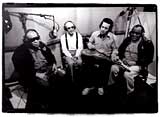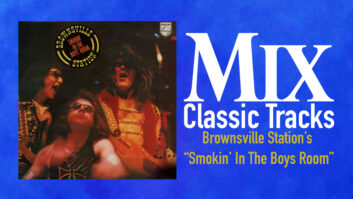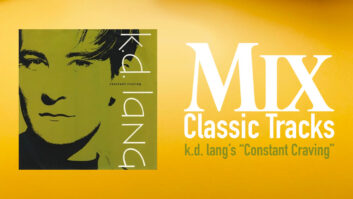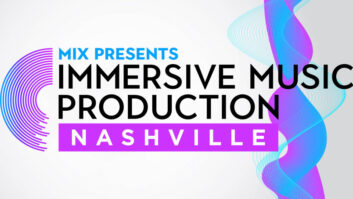
From left: Clarence Fountain, Jimmy Carter, Ben Harper and George Scott in the heat of a session
Photo: Steve Sherman
Ben Harper is standing in front of the vintage Neve 8068 console at Capitol Studios’ Studio B feeding lyrics to Blind Boy of Alabama Clarence Fountain. The legendary gospel singer is in the iso booth as the pair finish vocal overdubs to “There Will Be a Light,” one of 11 songs and the title track, on a new Ben Harper with the Blind Boys of Alabama offering due in early September from Virgin Records.
While Harper is clearly enthusiastic about the sessions, throwing up his hands in jubilation when Fountain nails a line, this collaboration almost didn’t happen. The Blind Boys team approached the singer/songwriter to produce an entire album for them, but Harper was busy with his own studio and live dates. “I’m making music at such a rapid pace in the studio right now — doing my own thing — that I didn’t want to pull away from that,” he says. “So at first I had to pass and then they came back and said, ‘Well, how about a couple of songs?’ It was such a privilege to be asked and I had to look at my life and say, ‘There should not be anything keeping me from working with these guys. They’re one of the musical wonders of the world. They’re like Niagara Falls or the Grand Canyon.’”
The idea was for Harper to produce two, maybe three songs for an upcoming Blind Boys release. So some time was booked at Capitol Studios, and engineer Jimmy Hoyson, executive producer Chris Goldsmith, the Blind Boys (which includes Fountain, vocalists Jimmy Carter and George Scott, Eric “Ricky” McKinnie on drums, rhythm guitarist Caleb Butler, lead guitarist Joey Williams and bassist Tracy Pierce) and musicians Juan Nelson (bass), Marc Ford (guitar), Michael Ward (guitar), Rock Deadrick (drums), Leon Mobley (percussion) and Jason Yates (keyboards) were assembled in late January. Harper, as producer, was aiming for a Muscle Shoals/Stax Records tone. Engineer Hoyson says, “I just thought big and warm and natural and old school. I wasn’t particularly thinking about any artist or label in the past; I just thought about making it organic.”
With that in mind, the project was recorded with a liberal dose of vintage gear. The vocal chain for Harper and the Blind Boys started with Neumann U47s running through either a Fairchild 670 compressor or an LA-2A into the Neve console’s mic pre’s. Capturing the Blind Boys’ vocals was a challenge. “It’s potentially scary,” Hoyson admits, “but not so much, because I’ve done it so much now. We almost always have all of them singing at one time and they’re able to deliver an incredible dynamic range at any given moment, so you find yourself gain-riding four or five mics to tape, trying to keep your levels under control and watching the compressors. The other challenge is obviously that they’re blind, so I’m constantly going out and making sure their microphones are positioned correctly. They have a tendency to reach out and touch them or feel where they are, and at the same time they rotate them.”
The majority of Harper’s vocals were recorded through a U47, as well, but on two songs he used a Neumann TLM 170 omni microphone that Hoyson had set up as a talkback mic. “Ben was out in the room while we were doing a bass and keyboard bass, guiding them through ‘Take My Hand’ and we got an amazing vocal,” Hoyson recalls. “It was a different sound and we just went with it. It didn’t have some of the depth of the U47 and the width and size, but it just worked for the song and it sounded good on his vocal.”
The team deviated from the vintage approach when a Pro Tools system was brought in, along with Pro Tools engineer Mike Glines. Harper and Hoyson tested analog vs. digital early on in the process: They actually recorded the Blind Boys to analog first and then dumped it to Pro Tools, but they quickly realized that for this project’s logistics, they needed the extra tracks. “I just knew that a 24-track analog machine wouldn’t handle this, track-wise,” Hoyson says. “I didn’t want to drag two machines [in there]; just locking up two analog machines would have been ridiculous and going to a 48-track machine was our only other option. That wasn’t something I wanted to do.” Hoyson knows that some would shy away from the digital format for a project like this one “because it seems to go counter to their desired end result, but I think with that console and old microphones and old outboard gear and an older approach, the album still sounds natural and organic and warm.”
At the end of the first set of studio dates — there were two — Harper looked around and realized that he was close to completing five songs. “In three days, I’m staring at the better part of a record, and if that’s not a sign post, I don’t know what is,” he recalls. “So we just went from there.”
Working with the Blind Boys turned out to be the fulfillment of a career goal for Harper, who has always wanted to make full rock, folk, blues, gospel and funk records. “Because on each of my albums, I’ve had to put away complete songs in each vein or a couple of really good ideas that are five minutes of focus away from being done. This is the moment and the opportunity. I’ve never used this phrase, but my God, it’s the opportunity of a lifetime to be able to have that material that I’ve felt this passionately about and to bring it to life at the highest level.”
For this gospel collection, he returned to songs that have been in his repertoire for the past seven years, including the title track “There Will Be a Light,” “Well Well Well,” “Church on Time” and “Take My Hand.” Harper and the Blind Boys also covered Jeff Buckley’s “Satisfied Mind” and offer an a cappella version of the traditional spiritual, “Mother Pray.”
The Blind Boys, who have won the Grammy Award for Best Traditional Soul Gospel Album three times in a row now, will only sing on spiritually based songs. “We sing gospel songs, so they have to have a gospel message before we can even think about recording it,” reports Blind Boy Carter. “These songs give a message that we can accept.”
“These are all religious songs,” echoes Fountain. “There ain’t no hanky panky in ’em. If there were, then we wouldn’t be singing. We know Ben sings rock ‘n’ roll, but he wanted to cut a gospel album, so we took him at his word.”
For Harper, working with these gospel greats was “extremely intimidating because of the legend and because of my heightened level of reverence for the men and the music they’ve created,” he says. “They’ve led me by the hand and I’ve done the same for them, but you know, when it comes to music, man, they see clearer than most people I’ve worked with. They know what they want to sound like and how they want their vocals to sound and move.”
To record the trio of guitarists — Harper, Ford and Ward — Hoyson used a combination of Neumann U67s, Royer 121 ribbon mics and Shure SM57s. “I tried to figure out what mic was working best for whatever sound we were going for and then just find the right balance. I kind of used the microphones to EQ with because, obviously, the 57 is going to be a little dirtier and a little more distorted, the 67 is going to have better clarity throughout top to bottom, and then the Royer is going to be a little friendlier, not so much high end; because it’s a ribbon mic, it’s going to be a little rounder.” Harper’s guitar went from the mics into an LA-3A compressor and then into a Pultec EQP-1A. To capture Harper’s slide guitar playing, Hoyson went DI, though it’s not his favorite mode of recording. “I don’t necessarily like the sound of a DI, but sometimes tucked in with the microphones, you get a little more body and clarity. So I use it as my clean signal, but I wouldn’t want to rely on it — it’s just an added thing.”
Once recording was completed, Hoyson turned to the challenge of mixing the 11 songs. First, he took the tracks home and automated vocal rides within Pro Tools. “I went through and balanced the Blind Boys and if there was anything glaring, like a bad headphone leak or if they bumped something, I cleaned it out,” he explains. “One thing that drives me crazy with analog is rewinding the tape 10 seconds four times in a row to where you finally grab the fader at the perfect moment to get one word. That’s the most useful thing for me personally in Pro Tools: to go in and do more detailed automation.
“On two of the songs — ‘Where Could I Go?’ and ‘Well Well Well’ — we used my rough mixes for the album,” Hoyson continues. “On ‘Well Well Well,’ Ben is playing a Resonator [a Dobro-like guitar] and it’s the most organic song on the album. It’s just him playing guitar with the Blind Boys singing, a kick drum and some percussion. So it’s pretty stripped-down and old school — sounding. The rough mix just had this vibe that I couldn’t beat and when I tried to perfect the balances of the background vocals and make it all nice, it became so boring. So maybe when you listen to the mix, all the Blind Boys’ parts aren’t balanced perfectly and it’s a little sloppy from a perfection standpoint, [but] it just has this great feeling to it.”
During the mix dates, Hoyson kept things relatively simple, using an EMT 250 as one of his primary reverbs, but also employing Capitol’s Les Paul — designed live chambers.
Not surprisingly, Harper would show up as the mixes neared completion, but Hoyson admits he was caught off-guard by the appearance of the entire band at Capitol Studios. “It would be me and Ben and the whole band finishing the mix together to a large degree,” he recalls. “To most engineers, that would scare the hell out of them. Usually you’re in there with the producer or with the main artist not getting that much input. But they were great. They weren’t concerned about their instruments; they were just concerned with the blend. They had fantastic input and great ears. They really helped the process.”
For their part, the Blind Boys could not have been more delighted. As Fountain notes, “Working with Ben was just as sweet as honey in a rock and I think this will bring us another Grammy. Yes, I’m pretty sure of it.”






